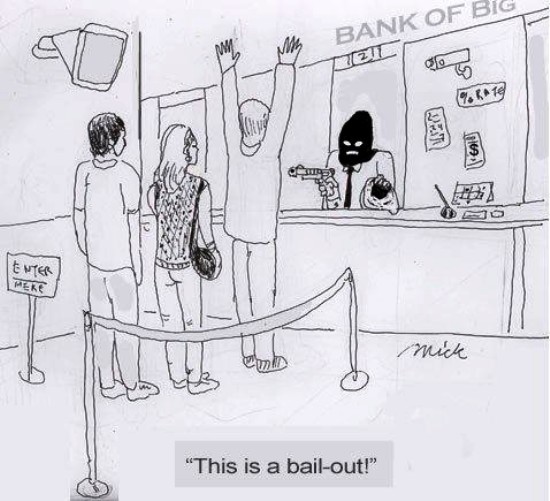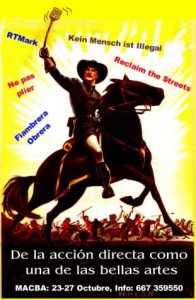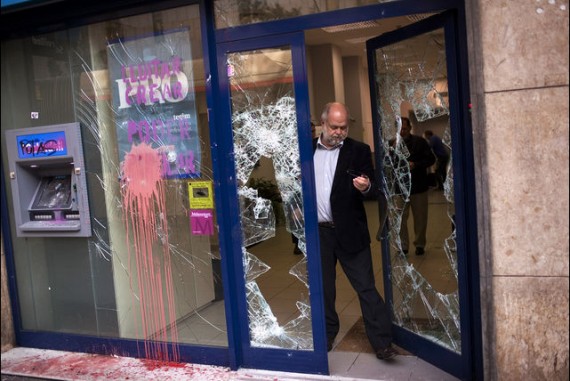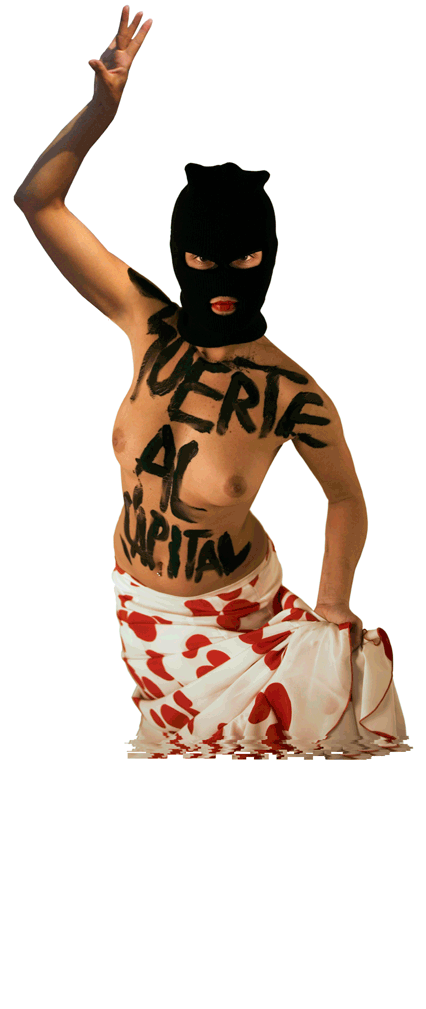How to Hold up a Bank: On riots and flamenco dancing.
26. 6. 2012 // John Jordan // Kategorie Randnotizen 2012 Last night one of the many small groups of invisible hands that rest on the keyboards of computers manipulating our society with their magic numbers and occult equations, downgraded 28 Spanish banks. Moodys rating agency hasnt been the target of much direct action (unfortunately.. any ideas out there ? ) but Spanish banks certainly have. Especially since Bankia with assests worth nearly a third of the entire Spanish economy stole 23 billion euros from the already suffering public purse.
Last night one of the many small groups of invisible hands that rest on the keyboards of computers manipulating our society with their magic numbers and occult equations, downgraded 28 Spanish banks. Moodys rating agency hasnt been the target of much direct action (unfortunately.. any ideas out there ? ) but Spanish banks certainly have. Especially since Bankia with assests worth nearly a third of the entire Spanish economy stole 23 billion euros from the already suffering public purse.
In this age of robin hood in reverse, where banks are robbing us in broad daylight, I thought it would be worth looking at different ways the banks are being targeted by Spanish activists. Spain has a long tradition of bank transformation, perhaps beginning with Durruti who used the money from bank robberies to fund anarchist schools for the poor. These days the weapons are somewhat more frivolous but are the ends as useful?
At the end of March I was invited to Barcelona for a gathering of art activists Como Acabar el Mal. I took the night train, the little plastic couchettes rattled down from Paris and I arrived in Barcelona preparing for a general strike. For reasons of climate justice I have stopped flying for the last 9 years. Climate Change is a war on the poor, a war that is happening here and now across the world. I dont want to fly in the planes that are delivering the carbon dioxide bombs which are pushing us to the brink of extinction and so I spend a lot of time on trains.
For me ethics and aesthetics are woven together like strands of DNA. One without the other is a death blow to what is beautiful. If we see the world as a series of interconnected worlds, of networks and webs, of relationships rather than just atoms, then it is impossible to separate one from the other. To chose aesthetics over ethics is to ignore the beautiful in everyday life, it is to ignore that true creativity is to enable the creativity of others and the natural world to blossom. It is forgetting that some of the most beautiful things in life are the way we can be human together.
Only when we turn a blind eye to the shadows and separate the world into little isolated pieces, only when we stop feeling the world, only then can such paradoxes such as a great work of art funded by a bank be able to split our culture apart. A work of art funded by a bank can only be beautiful when we ignore that the same bank evicts families from their homes or fuels climate change by funding oil exploration. Ignoring the relationships is an act of ugliness. Art is the science of connections, usual and unusual.
To chose ethics over aesthetics is equally problematic. Why build a political movement which envisions a culture that is dull and undesirable. Why write political texts that dont make your heart race like poetry. Why chose to live well if its not a beautiful thing to do. If we cannot make changing the world the most desirable activity worth doing in our life times, then we might as well give up now.

Barcelona has been a key place for art activism over the last decade. Ten years ago a gathering of different international groups took place, out of which came a whole series of actions and movements. Including the infamous YOMANGO group, who turned shop lifting into an art, the veterans of which set up this second meeting a decade on. The idea was to attract the young indignados movements and open a window to other forms of creative action for them.
I gave a slide talk ( see an edit of it here ) and the next day we were on the streets as the country was shut down by the general strike.
DIRECT ACTION
During the strike, many banks in barcelona were targetted. The outcome were classics of the iconography of the European riots and many might argue a beautiful act of anger – colourful and dramatic.

But is it politically effective? For me the key to direct action is that it has both a symbolic and a practical political effect. Symbolically it is clear that smashing the facades of banks creates a striking picture of resistance, which is why anyone doing such a thing is always surrounded by media cameras and the images easily make the front pages of the newspapers. Its direct in that its not asking for things to change, not asking leaders to make decisions for us, but taking control of our own lives and making the change here and now.
If a direct actionist sees someone who is hungry they feed them rather than write to politicians complaining about poverty. If she sees someone who is homeless she squats a building rather than protest against poor housing provision. Direct action is the difference between protest and resistance, and as far as Im concerned it is resistance that has historically changed the world a lot more than mere protest.
When I worked with Reclaim the Streets in the 90s we defined Direct action on our (very 90s looking web site) thus:
DIRECT ACTION enables people to develop a new sense of self confidence and an awareness of their individual and collective power.
DIRECT ACTION is founded on the idea that people can develop the ability for self rule only through practice, and proposes that all persons directly decide the important issues facing them.
DIRECT ACTION is not just a tactic, it is individuals asserting their ability to control their own lives and to participate in social life without the need for mediation or control by bureaucrats or professional politicians.
DIRECT ACTION is not a last resort when other methods have failed, but the preferred way of doing things.
Burning a cash machine can be seen as a form of direct action, but does it really affect the bank beyond the symbolic? Does it really have a direct effect on its unethical activity? Is it a useful weapon against the dictatorship of the markets? Does it tell a good story?
It certainly has its cathartic aspect for the resister, and when the mind and body feels free, when the endorphins of pleasure flow through our veins as we resist it certainly makes the action therapeutic and healing in this dark world difficult world. But the images of broken windows easily become fuel for the criminalisation of movements, enabling repression and the creation of new laws that curb dissent. The Spanish government following the huge indignados camps last year, has already proposed a law which would make it “an offense to breach authority using mass active or passive resistance against security forces and to include as a crime of assault any threatening or intimidating behaviour”, and simply blockading traffic or using social media to organise protest could mean jail for two years.

The fear of chaos is a useful tool for governments. Wanting to re imagine the classic iconography of protest that the media spew out and to play with forms of direct action that cannot be turned into campaigns of fear and terror by the authorities, one of the groups presenting at acabar con el mal has another way of using a bank as a canvas for a resistant art work. Over the last few years the art activist group flo6x8 has held extraordinary disobedient flamenco dances inside banks. This video of their recent actions shows how with skill and artfulness political protest can be beautiful and popular, 811,000 people have watched this! We might ask however, how open such actions are to people who are not expert flamenco dancers?
An answer was provided last month when a group that was formed during the workshops of acabar con en mal came together to hold a somewhat more wild and free party inside a branch of Bankia. Much more participatory perhaps but as effective ?
So here we have 4 ways to hold up a Spanish bank. Durutiis pistol, the black bloc redecoration, the flamenco occupation and the party. . Again the question remains how do these actions really affect the bank. They clearly show people enjoying disobedience, and they make direct action desirable rather than fearful both of which are key political acts that help nurture movements. But in the end the bank has only been symbolically affected, the rioter is in the end no more effective than the flamenco dancer.
As I was leaving Barcelona someone passed me a copy of a free newspaper, REBEL! It was called, it had been printed in an edition of 500,000 and described new ways that people across Spain are setting up alternatives to the economic dictatorship: cooperatives, alternative currencies, schools, self managed health centres to name a few of the initiatives. The paper was funded by Enric Duran. I met the quiet introverted catalan ten years ago when the first art activist conference took place in Barcelona, little was I to know how infamous he was to become.
In 2008 he published another free newspaper CRISIS! which described how he managed to steal nearly half a million euros from 39 Spanish banks. I deliberately carried out an individual disobedience action towards banking, he wrote, to denounce the banking system and to use the money for supporting initiatives which alert us to the systemic crisis that we are starting to inhabit and which intend to build an alternative society. The article became known all around the country and earned him the nickname Robin Bank. He had managed to take out loans that he never intended to pay back and all the money was given to postcapitalist projects. When the act was announced the media story went viral and Duran had to flee the country for fear of prosecution.
He had perhaps found the most effective way to hold up a bank, in a kind of act of jujitsu the banks own weapon of debt, a weapon that holds individuals and entire economies in states of dependence, was turned against them . It was an action that merged the symbolic, in the form of great story telling, and the pragmatic, in the form expropriating wealth and supporting social movements. He was practicing the true art of Situationist detournement, direct action in its most beautiful form!
Perhaps the last word should be left to Gustav Landuaer, whose strategy of a living revolution envisioned a network of alternative communities that would divert creativity away from capitalism thus withering its institutions, famously wrote: One can destroy a pane of glass (but) The State is a condition, a certain relationship between human beings, a mode of behaviour; we destroy it by contracting other relationships, by behaving differently toward one another… We are the State and we shall continue to be the State until we have created the institutions that form a real community.


